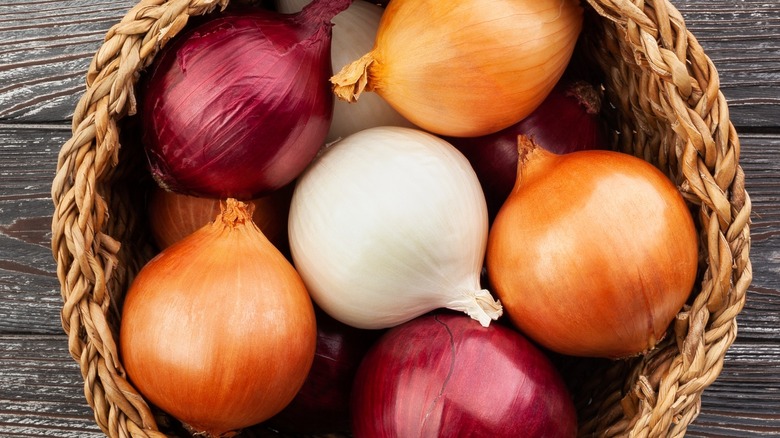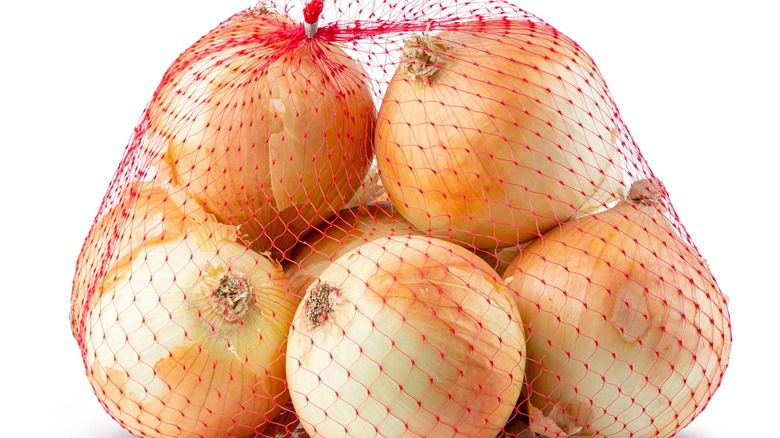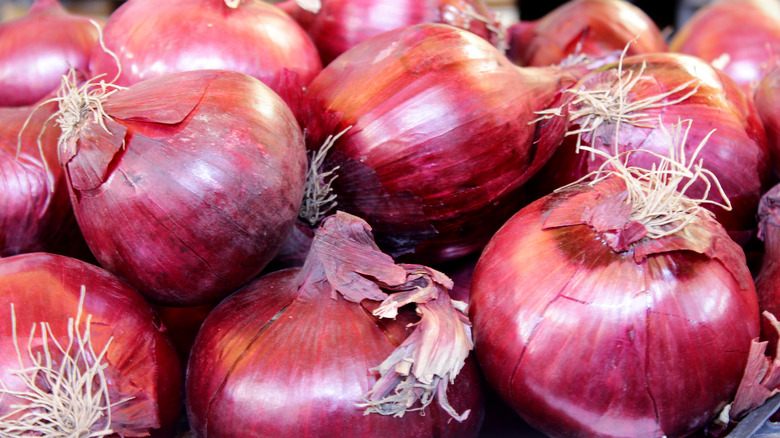The Onions You Should Always Use If A Recipe Doesn't Specify
Thanks to the millions of free recipes available on the internet, there's never been a better time to learn to cook. The only problem is, a lot of them aren't written by professional recipe developers, so the details can leave a lot to the imagination — especially when it comes to onions. If you're up against a list of ingredients, and you're not sure which type of onions to buy, the best choice is the simplest: Go for regular yellow onions, like the kind that come in a plastic mesh bag by the pound.
There's a reason yellow onions are found in every grocery store in the U.S. — they are super versatile, deliver strong onion-y flavor, and are inexpensive. Don't get distracted by a display of sweet, red, or white onions competing for your attention if you're out shopping, because good old yellow onions have all the aromatic power you need for any recipe that calls for just "onions."
Yellow onions are all-purpose powerhouses
We are lucky to live in a time when there are lots of choices in the produce section. The U.S. alone grows more than 100 different varieties of apples, for example. But when it comes to onions, there's no need to mess with the success of yellow onions. In fact, yellow onions — which are sometimes called brown onions – make up nearly 90% of all the onions grown and sold in America, which is why most of us don't think of them as yellow onions, we just call them "onions" — kind of like "bananas." Because of this, almost every recipe you come across that calls for onions is probably referring to yellow onions.
The secret of the yellow onion's success is that it has a strong, sharp, clean onion flavor that holds up to lots of other ingredients without competing for the spotlight. They're a little too severe for eating raw for a lot of folks, however, they mellow out when they're roasted and sautéed, and they're the best onion choice for elevating caramelized onions. Plus, yellows lack starch and get sweeter as they cook, so they don't break down into mush or get flavorless when you heat them, even in soups and stews.
Yellow onions versus other onion varieties
If you don't have any yellow onions on hand, but you have a red or white onion in the kitchen, don't stress too much about whether your recipe will come out okay. All storage onions — that is, yellow, red, and white onions — can be used pretty interchangeably in any recipe and behave similarly when they're cooked. The only difference between them are the colors, of course, and some subtle flavor variations.
White onions look whiter than yellow onions, are typically a little larger, and they have thinner skins. They're also slightly sweeter than yellows when they're raw, which makes them ideal for slicing and serving on salads and cut up into fresh sauces and salsas like pico de gallo. Red onions have a strong, sweet, and spicy flavor and are excellent served raw on top of a burger or diced for ceviche. Their sweet qualities make them ideal for pickling, as well.
As for sweet onions, these seasonal treats are much milder than yellow onions and they don't like to be stored for very long. Eat them while they're fresh raw in a salad, or grill a few slices for your next cookout. Also, if a recipe calls for Spanish onions, these are just a subtype of yellow onions that are a bit sweeter than their mainstream brethren. If you can only find yellow onions, just use an extra if they're small so that you get the same volume as you would with a larger Spanish onion.


